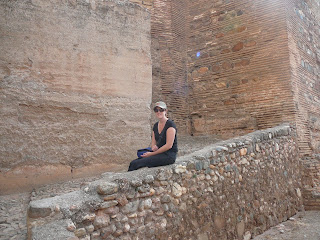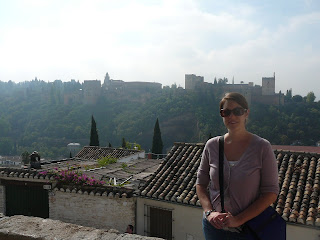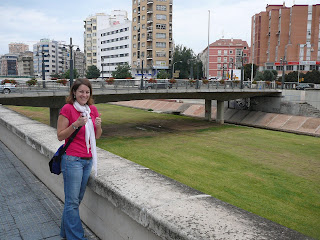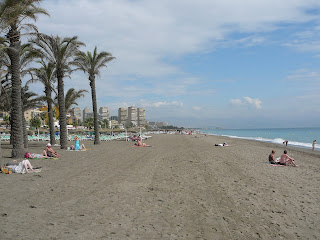 Thursday
ThursdayLuckily our hotel was close to the train station, so we checked in there and then set off to the Santa Cruz region in the heart of Seville’s old town. We followed our noses and ears through a maze of tiny alleyways until we found a little back street not far from the cathedral that was packed with restaurants and tapas bars. The one we chose was fantastic. We love tapas – not only the delicious food, but the ability to order 6-7 different things from a menu is perfect for people as gastronomically indecisive as we can be! We were introduced to possibly the most delicious thing in the world – “pinchito de pollo”, which are perfectly cooked tender marinated chicken pieces on skewers. They were so good we went back the following night for some more!
After dinner we wandered to the main square surrounding the cathedral. The magnificent cathedral and its bell tower (La Giralda) were all lit up at night and looked so pretty. Just across the square from the cathedral is the fortress wall of the Alcazares, part of which was also lit up. We were both instantly fans of Seville!
Friday
There were a lot of things we wanted to see in Seville and, with only two days there, we had to get cracking early (well, relatively early) to make sure we fitted it all in. Tim had taken note of some of the attractions from the guidebook – and while we had decided that we never wanted to visit another church or cathedral again following our tour of Italy in July, the guidebook twisted our arm into visiting the Seville cathedral. It opened at 11am, so after wandering back into the Santa Cruz region and getting some breakfast, we had a bit of time to fill in.
We decided to check out the Plaza Santa Cruz, which turned out to be hidden in the middle of a labyrinth of streets. We must have circled it from different angles several times before we finally found it and pounced. After all the effort it is was a bit of anti-climax, but the plaza was still very pretty and very quiet – because no tourists could find it!
The area around the cathedral gates at 11am was a bit like feeding time at the zoo. Most Europeans don’t understand (correction: don’t give a crap about) the concept of a queue and just barge on in there with elbows flying. So we raised our elbows and joined in the scrum. We got in fairly quickly and bought our tickets but then had to wait at the audio guide stall for about a week behind two French women who must have been requesting not only instructions on how to use their audio guide, but also a blow-by-blow history of the audio guide, a breakdown of the materials used in manufacturing an audio guide, 1000 interesting things you could do with an audio guide (like hitting annoying slow people over the head with it) and also a summary of world events for the past two millennia. Seriously, the cathedral almost closed for the day while they were getting their audio guides. Ridiculous.
The Cathedral of Seville (or the Cathedral of St Mary of the See) is the largest Gothic cathedral in the world, and the third largest church in the world (after St Peter's in the Vatican City and St Paul's in London). The cathedral was built to demonstrate Seville's wealth, as it had become a major trading centre in the years after the Christian reconquest. Construction began in 1402 on the site of a former mosque, following the capture of Seville from the Moors; it continued until 1506. Next to the cathedral is the magnificent La Giralda bell tower. The tower, a minaret (Muslim tower) from the Almohad period of Seville, is constructed in several distinct parts, the lower two thirds being almohad architecture, and the upper third Spanish renaissance architecture.
With audio guides in hand, we checked out the amazing interior of the cathedral. The highlights of the visit were climbing to the top of La Giralda for superb views over Seville, the amazing Gothic alter piece (composed of 45 carved scenes from the life of Christ, carved in wood and covered with staggering amounts of gold), the tomb of Christopher Columbus and the Courtyard of Oranges (a large outdoor courtyard full of orange trees and a beautiful Moorish fountain). There was also an insane amount of quality artwork decorating the walls and a "treasury" room.
After our very enjoyable visit to the cathedral, we walked to Murillo's Gardens, a public garden in the Santa Cruz region. It was hot and sunny in Seville and reached 36 degrees by mid-afternoon, so some shade under the trees of the garden was very welcome. The main attraction of these gardens is the monument to Christopher Columbus. Columbus was sent out to explore on the good ship "Santa Maria" by Ferdinand and Isabel in 1492 and happened upon a rather large piece of dirt now called America. Great explorers, those Spaniards. Just next to the gardens is a street full of eateries, so we sat ourselves down there amongst students and fellow tourists and had some lunch.
With stomachs re-stocked, we continued south to the Plaza de Espana. The Plaza de Espana is one of Seville's most famous buildings and the epitome of the Moorish revival in Spanish architecture. In 1929 Seville hosted the Spanish-American Expo and numerous buildings were constructed for the exhibition in Maria Luisa Park, among them the Plaza designed by Anibal Gonzalez. The Plaza is a huge half-circle with buildings running right around the edge accessible over a moat by numerous beautiful bridges. In the centre is a large fountain. In front of the buildings all the way around are wall plaques representing all of the provinces of Spain.
After spending some time checking out the Plaza de Espana, we headed across the road to the large Maria Luisa Gardens. We sat down on a park bench for a rest in the shade and consulted our travel guidebooks to see if we could find a place to see some flamenco dancing that night. While we were busy reading our books, a guy stopped in front of us to ask us for directions. It was odd because he appeared to be speaking Spanish to start with (so why would he ask us for directions?) although he was wearing an Italian football shirt. We politely told him we only spoke English and could not help him. But he kept rambling in Spanish and then threw in a few French words and was waving his arms around all over the place. We again told him that we did not understand, as we only spoke English, and we didn’t know where anything was anyway. He was acting very strangely, as he kept looking behind us as he was talking, which is always rather disconcerting. Tim was thinking that there was something very odd about this guy, just as he felt his backpack (which was sitting on the bench beside him) start to slide off the bench. Tim grabbed it and spun around to see this guy’s mate standing right behind us, trying to steal the backpack while we were distracted by the first guy. Just as Tim grabbed his bag, two women who were sitting on a bench across from us had seen what was happening and yelled out to warn us, which was nice of them. These guys, realising they had been sprung, did not run off, but rather stood there and threw stones at the women and abused them in Spanish for warning us. We could not believe how casual they were about the whole thing. Anyway, it was very lucky that we rescued the bag just in time, as it contained some precious cargo in the form of Bear! There was no money or passports or anything like that in the bag, but we would have been pretty gutted if we lost Bear to some thieving Spaniards after 30 countries…
After that excitement, we carried on exploring the gardens and found our way to the museum of art and fashion, great for photos (see below). Back in the city centre, we had a look at a few shops and then returned to the hotel for a mini siesta – more of a change of clothes and a drink, before setting out for the evening.
Feeling refreshed and excited about a Friday night in the middle of Seville, we found a busy little bar close to the cathedral where we sat outside with a jug of sangria and watched the world go by. Our next stop was the place we had had dinner at the night before – we stopped in for a drink and some pinchito de pollo (so yum) as an entrée and then we carried on to a different restaurant for dinner. The plan had been to find a bar and watch some flamenco dancing after dinner. We had found plenty of places that offered full on flamenco dancing shows, where you sat down in a theatre and watched for 2-3 hours, but we didn’t really fancy that and plus they were really expensive. What we were looking for was a bar that had a bit of flamenco as the night’s entertainment. Apparently there were plenty of these around the city but we could not find any. Oh well. Instead we grabbed an ice cream for dessert and enjoyed a leisurely walk through Santa Cruz and back to the hotel. It had been a long hot day with plenty of walking, so we were pretty shattered.
Saturday
Saturday was our last day in Spain and there was still so much to see in Seville. We tried a different place for breakfast and it was really good – even better than Friday morning’s place. Unsurprisingly, the orange juice is very good in Spain!
Our first activity of the day was a river cruise. We walked across to the El Arenal region and found the Torre del Oro (which means Golden Tower). It was quite majestic. The tower was built by the Moors in 13th century and apparently got its name as it either used to be a store for gold and other treasure that had been brought back from naval explorations and/or was covered in gold gilt. These days the tower is home to a naval museum. Right next to the tower, we boarded our boat and set off for a one-hour cruise along the River Guadalquivir. A lot of the attractions that were pointed out to us were the bridges that we passed under, although it was interesting to note how much had been built in 1991 in the lead-up to the Expo ’92, held in Spain. There were several new bridges linking the main part of Seville to the large area on the west-side of the river where the Expo was held, as well as many new buildings, towers and other constructions, most of which were built just prior to the Expo in 1992. There was plenty of activity – kayakers, rowers, fishermen all making use of the river and dozens of people jogging or cycling along the side of the river.
Back on dry land, we decided to do a tour of the Real Plaza de la Maestranza bullring. This bullring is the second-oldest in Spain after the one in Malaga and is one of the most beautiful and famous bullrings in the world. Our 20 minute tour began with a look inside the bullring where we were given a brief explanation of what happens during a bull-fight and shown the various gates to the bullring – depending on whether a bull-fighter wins, loses or requires hospital treatment, he will use a different gate to exit from the bullring! Then the tour continued underneath the stadium, where there is a small museum of the history of bullfighting in Seville. And it concluded with a quick look at the stables, where the horses are kept in one side and the bulls in the other side, and the chapel, where bull-fighters go to pray before a fight! It was very interesting – something rather unique.
Surprise, surprise, it was tapas for lunch again. Not that we were sick of it, quite the opposite. After lunch we visited the Alcazares (Seville’s answer to the Alhambra in Granada). The Alcazares is smaller and a lot more compact than the massive, sprawling Alhambra, but it was also very pretty. This time we got some audio guide action, which meant we got some key info as we wandered around. We saw several couples posing for wedding photos in the Alcazares as we wandered around - and it really would be an amazing place for wedding photos. Our favourite part was the Mercury Fountain at the beginning of the Alcazares Gardens - a big square fountain with a statue of Mercury in the centre and water falling from a few metres above the fountain. Very cool.
It was another hot day in Seville – up around the 36 degree mark at one stage – so after the tour of the Alcazares, we decided to grab an ice cream and have a cruisy afternoon checking out some shops. We also walked back across to the other side of the river, across a fine bridge, which was probably constructed in 1991, and had a drink on Calle Betis (Betis Street). During our river cruise we had spotted the street running along the river on the west-side. It was packed full of bars and restaurants and looked really fun. So we had a drink there, looking out across the river to the centre of Seville on the other side.
That brought an end to our southern Spain sojourn. We both loved Seville in particular and may even return at some stage. We were keen to visit Gibraltar too, but we ran out of days, so another trip down that way may be on the cards in the future. No addition to the country tally, as we had been to Spain before, but we were grateful to leave with Bear still in our possession! Next up, Iceland in mid-November…it’s probably not going to be 36 degrees there.

Seville
Cathedral

La Giralda
Tower

Columbus
Monument

Plaza de
Espana

Still with
us

Plaza
again

Barcelona
wall mural

Parque
de Maria
Luisa

Museum of
art and
fashion

Tapas bar
with ponchito
de pollo

La Giralda

Torre
del Oro

Our river
boat

Bullring

Inside
the bullring

Alcazares

Inside
Alcazares

Ditto


Alcazares
Gardens













































